Difference between revisions of "UBPML Referenz"
AndreasLeue (talk | contribs) |
AndreasLeue (talk | contribs) |
||
| Line 4: | Line 4: | ||
{| class="dgmtable" | {| class="dgmtable" | ||
!bgcolor="#F0F0FF"| Notation | !bgcolor="#F0F0FF"| {{T|Notation|Notation}} | ||
!bgcolor="#F0F0FF"| Bedeutung | !bgcolor="#F0F0FF"| {{T|Bedeutung|Semantics}} | ||
!bgcolor="#F0F0FF"| Konformität | !bgcolor="#F0F0FF"| {{T|Konformität|Conformity}} | ||
|- | |- | ||
| [[Image:UBPMLClass.png]] | | [[Image:UBPMLClass.png]] | ||
| Eine Klasse | | {{T|Eine Klasse|A class}} | ||
| [[UML]] standard | | [[UML]] standard | ||
|- | |- | ||
| [[Image:UBPMLObject.png]] | | [[Image:UBPMLObject.png]] | ||
| Eine Instanz einer Klasse | | {{T|Eine Instanz einer Klasse|An instance of a class}} | ||
| [[UML]] standard | | [[UML]] standard | ||
|- | |- | ||
| [[Image:UBPMLClassInState.png]] | | [[Image:UBPMLClassInState.png]] | ||
| Eine Klasse in einem bestimmten Zustand | | {{T|Eine Klasse in einem bestimmten Zustand|A class in a certain state}} | ||
| UBPML | | UBPML | ||
|- | |- | ||
| [[Image:UBPMLClassInStateWithDefinition.png]] | | [[Image:UBPMLClassInStateWithDefinition.png]] | ||
| Eine Klasse in einem bestimmten Zustand. Dieser Zustand wird hier ebenfalls deklariert, und zwar in Form einer Bedingung, die dann und nur dann erfüllt ist, wenn der Zustand vorliegt. | | {{T|Eine Klasse in einem bestimmten Zustand. Dieser Zustand wird hier ebenfalls deklariert, und zwar in Form einer Bedingung, die dann und nur dann erfüllt ist, wenn der Zustand vorliegt.|A class in a certain state. The state itself is also declared here, and that by specifying a condition, which true and only true if that state is given.}} | ||
| UBPML | | UBPML | ||
|- | |- | ||
| [[Image:UBPMLObjectInState.png]] | | [[Image:UBPMLObjectInState.png]] | ||
| Eine Instanz einer Klasse in einem bestimmten Zustand. | | {{T|Eine Instanz einer Klasse in einem bestimmten Zustand.|An instance of a class in a certain state.}} | ||
| [[UML]] standard (seit 2.0 in Aktivitätsdiagrammen) | | [[UML]] standard (seit 2.0 in Aktivitätsdiagrammen) | ||
|- | |- | ||
| Line 35: | Line 35: | ||
--> | --> | ||
| [[Image:UBPMLConstellationClass.png]] | | [[Image:UBPMLConstellationClass.png]] | ||
| Ein bestimmter Zustand des Systems, der durch eine Menge von Klassen (d.h. eine ''Konstellation'') in einem bestimmten Zustand beschrieben wird, sowie optional weiteren Bedingungen, die für diese Klassen sowie ihre Beziehungen untereinander gelten müssen. Eine ''Konstellation'' ist eine UML Klasse, also im Metamodell abgeleitet von ''Klasse''. | | {{T|Ein bestimmter Zustand des Systems, der durch eine Menge von Klassen (d.h. eine ''Konstellation'') in einem bestimmten Zustand beschrieben wird, sowie optional weiteren Bedingungen, die für diese Klassen sowie ihre Beziehungen untereinander gelten müssen. Eine ''Konstellation'' ist eine UML Klasse, also im Metamodell abgeleitet von ''Klasse''.|A certain system state, defined by a set of classes (i.e a ''Constellation'') in certain states, as well as optionally additional constraints that have to be met by that classes and their relationships. A ''Constellation'' is a UML class, i.e. dervied from ''Class'' in the metamodel.}} | ||
| UBPML | | UBPML | ||
|- | |- | ||
| [[Image:UBPMLConstellationObject.png]] | | [[Image:UBPMLConstellationObject.png]] | ||
| Eine Instanz einer Konstellation, also eine Menge von Instanzen in bestimmten Zuständen, die die Bedingungen der Konstellations-Klasse erfüllen. | | {{T|Eine Instanz einer Konstellation, also eine Menge von Instanzen in bestimmten Zuständen, die die Bedingungen der Konstellations-Klasse erfüllen.|An instance of a Constellation, i.e. a set of instances in certain states, which satisfy the constraints of the Constellation-class.}} | ||
| UBPML | | UBPML | ||
|- | |- | ||
| Line 49: | Line 49: | ||
--> | --> | ||
| [[Image:UBPMLStepClass.png]] | | [[Image:UBPMLStepClass.png]] | ||
| | | {{T|Ein Schritt (''Step'') beschreibt eine Veränderung (Transformation) des Systems von einer Konstellation in ein oder alternativ mehrere andere. Er stellt somit die elementare Einheit einer ''geplanten Veränderung'' dar. Ein ''Schritt'' ist eine UML Klasse, also im Metamodell abgeleitet von ''Klasse''.|A ''Step'' denotes a change (transformation) of the system from one constellation into possibly several alternative other ones. It is thereby the elementary unit of a ''planned change''. A ''Step'' is a UML class, i.e. dervied from ''Class'' in the metamodel.}} | ||
Ein Schritt (''Step'') beschreibt eine Veränderung (Transformation) des Systems von einer Konstellation in ein oder alternativ mehrere andere. Er stellt somit die elementare Einheit einer ''geplanten Veränderung'' dar. | |||
| UBPML | | UBPML | ||
|- | |- | ||
| [[Image:UBPMLStepObject.png]] | | [[Image:UBPMLStepObject.png]] | ||
| Eine Instanz eines Schrittes. Diagramme, die Instanzen von Schritten beinhalten können zur Beschreibung von ''Projekten'' verwendet werden. Auf diese Weise werden Projekte und Prozesse in einer einheitlichen Notation verknüpft. | | {{T|Eine Instanz eines Schrittes. Diagramme, die Instanzen von Schritten beinhalten können zur Beschreibung von ''Projekten'' verwendet werden. Auf diese Weise werden Projekte und Prozesse in einer einheitlichen Notation verknüpft.|An instance of a Step. Diagrams containing Step instances may serve to describe ''Projects''. Thereby it is possible to describe Projects and Processes within one uniform notation.}} | ||
| UBPML | | UBPML | ||
|- | |- | ||
| [[Image:UBPMLProcedure.png]] | | [[Image:UBPMLProcedure.png]] | ||
| Ein Schritt besschreibt, ''was'' getan werden, welche Veränderung stattfinden soll. Er legt nicht fest, ''wie'' dies geschieht. Dies erfolgt durch Zuordnung einer ''Prozedur'' zu einem Schritt. Prozeduren können verschiedenes sein: eine Handlungsanweisung für einen Mitarbeiter, eine verfeinerte Vorgehensweise oder eine maschinelle Operation (Aufruf eines Dienstes). Verfeinerte Vorgehensweisen wiederum können entweder aus UBPML Schritten oder aber aus BPMN- bzw. UML-Aktivitäten bestehen. | | {{T|Ein Schritt besschreibt, ''was'' getan werden, welche Veränderung stattfinden soll. Er legt nicht fest, ''wie'' dies geschieht. Dies erfolgt durch Zuordnung einer ''Prozedur'' zu einem Schritt. Prozeduren können verschiedenes sein: eine Handlungsanweisung für einen Mitarbeiter, eine verfeinerte Vorgehensweise oder eine maschinelle Operation (Aufruf eines Dienstes). Verfeinerte Vorgehensweisen wiederum können entweder aus UBPML Schritten oder aber aus BPMN- bzw. UML-Aktivitäten bestehen.|A Step describes ''what'' shall be done, which change shall happen. It does not fix ''how'' this is achieved. The latter happens by assigning a ''Procedure'' to the Step. There are different types of Procedures: manual instructions, a refined proceeding or execution of machine operations (invocation of a service). Refined proceedings then may be described with UBPML Steps or BPMN- resp. UML-activities.}} | ||
| [[UML]] standard | | [[UML]] standard | ||
|- | |- | ||
| [[Image:UBPMLStepClassWithConstellations.png]] | | [[Image:UBPMLStepClassWithConstellations.png]] | ||
| Jedem Schritt ist genau eine ''initiale'' Konstellation zugeordnet, sowie eine oder mehrere finale, sich wechselseitig ausschließende Konstellationen. Die Verbindungspfeile sind notationell entlehnt aus Zustandiagrammen (Transitionen) und heißen hier ''Transformationen''. | | {{T|Jedem Schritt ist genau eine ''initiale'' Konstellation zugeordnet, sowie eine oder mehrere finale, sich wechselseitig ausschließende Konstellationen. Die Verbindungspfeile sind notationell entlehnt aus Zustandiagrammen (Transitionen) und heißen hier ''Transformationen''.|Each Step is associated with exactly one ''initial'' Constellation, as well as at least one but possibly several ''final'', mutual exclusive ones. The relationship arrows are borrowed from state transition diagrams (transitions) and named ''Transformation'' here.}} | ||
| UBPML | | UBPML | ||
|- | |- | ||
| [[Image:UBPMLStepObjectWithConstellations.png]] | | [[Image:UBPMLStepObjectWithConstellations.png]] | ||
| Eine Instanz eines Schrittes verbunden mit Konstellations-Instanzen. Diese Notation ist bpsw. in Projekt-Diagrammen verwendbar. | | {{T|Eine Instanz eines Schrittes verbunden mit Konstellations-Instanzen. Diese Notation ist bpsw. in Projekt-Diagrammen verwendbar.|xxx}} | ||
| UBPML | | UBPML | ||
|- | |- | ||
| [[Image:UBPMLConstellationClassAggregate.png]] | | [[Image:UBPMLConstellationClassAggregate.png]] | ||
| Stellt die Details einer Konstellation als Aggregation dar: eine Konstellation besteht aus Klassen in einem bestimmten Zustand, diese Klassen werden dargestellt. | | {{T|Stellt die Details einer Konstellation als Aggregation dar: eine Konstellation besteht aus Klassen in einem bestimmten Zustand, diese Klassen werden dargestellt.|xxx}} | ||
| UBPML | | UBPML | ||
|- | |- | ||
| [[Image:UBPMLConstellationObjectAggregate.png]] | | [[Image:UBPMLConstellationObjectAggregate.png]] | ||
| Stellt die Details einer Konstellations-Instanz als Aggregation dar | | {{T|Stellt die Details einer Konstellations-Instanz als Aggregation dar|xxx}} | ||
| UBPML | | UBPML | ||
|- | |- | ||
| [[Image:UBPMLConstellationClassPane.png]] | | [[Image:UBPMLConstellationClassPane.png]] | ||
| Alternative Darstellungsweise der Details einer Konstellation, entspricht der vorigen Darstellung als Aggregation. | | {{T|Alternative Darstellungsweise der Details einer Konstellation, entspricht der vorigen Darstellung als Aggregation.|xxx}} | ||
| UBPML | | UBPML | ||
|- | |- | ||
| [[Image:UBPMLConstellationObjectPane.png]] | | [[Image:UBPMLConstellationObjectPane.png]] | ||
| Stellt die Details einer Konstellations-Instanz alternativ dar | | {{T|Stellt die Details einer Konstellations-Instanz alternativ dar|xxx}} | ||
| UBPML | | UBPML | ||
|- | |- | ||
| [[Image:UBPMLStepWithClassesInState.png]] | | [[Image:UBPMLStepWithClassesInState.png]] | ||
| Anstelle der Konstellationen können auch die konstituierenden Klassen in einem bestimmten Zustand direkt mit dem Schritt verknüpft werden. Dies ist nur eine Vereinfachung in der Darstellung, implizit werden hierdurch ebenfalls (anonyme) Konstellationen definiert. Wird eine Klasse in einem bestimmten Zustand hierbei mehrfach in unterschiedlicher Bedeutung referenziert, so sind Rollennamen zur Unterscheidung zu verwenden. | | {{T|Anstelle der Konstellationen können auch die konstituierenden Klassen in einem bestimmten Zustand direkt mit dem Schritt verknüpft werden. Dies ist nur eine Vereinfachung in der Darstellung, implizit werden hierdurch ebenfalls (anonyme) Konstellationen definiert. Wird eine Klasse in einem bestimmten Zustand hierbei mehrfach in unterschiedlicher Bedeutung referenziert, so sind Rollennamen zur Unterscheidung zu verwenden.|xxx}} | ||
| UBPML | | UBPML | ||
|- | |- | ||
| [[Image:UBPMLStepWithClassesInStateAlternativeOutcome.png]] | | [[Image:UBPMLStepWithClassesInStateAlternativeOutcome.png]] | ||
| Da Ergebnisklassen in mehreren Zielkonstellationen auftreten können, müssen diese im Falle der alternativen Darstellung zugeordnet werden können. Dies erfolgt in Form der Angabe der jeweiligen Zielkonstellation als Bedingung. | | {{T|Da Ergebnisklassen in mehreren Zielkonstellationen auftreten können, müssen diese im Falle der alternativen Darstellung zugeordnet werden können. Dies erfolgt in Form der Angabe der jeweiligen Zielkonstellation als Bedingung.|xxx}} | ||
| UBPML | | UBPML | ||
|- | |- | ||
| [[Image:UBPMLStepAttributes.png]] | | [[Image:UBPMLStepAttributes.png]] | ||
| Da Schritte auch Klassen sind, können sie wie diese natürlich auch Attribute aufweisen. Die Befüllung der Attribute zu Beginn und zum Ende kann an den Transformations-Relationen angegeben werden. | | {{T|Da Schritte auch Klassen sind, können sie wie diese natürlich auch Attribute aufweisen. Die Befüllung der Attribute zu Beginn und zum Ende kann an den Transformations-Relationen angegeben werden.|xxx}} | ||
| [[UML]] standard | | [[UML]] standard | ||
|- | |- | ||
| [[Image:UBPMLInstantiation.png]] | | [[Image:UBPMLInstantiation.png]] | ||
| Durch Angabe einer Multiplizität von 1 am initialen Transformationspfeil auf Seite des Schrittes wird ausgesagt, daß zu jeder Instanz einer Startkonstellation genau ein Schritt existieren soll. Damit wird ausgedrückt, daß automatisch eine Verarbeitung initiiert wird. Alternativ kann durch Angabe einer Zeitfolge (bspw. "jeder 1 Montag im Monat") an einem Timersymbol eine Instantiierung spezifiziert werden, die zeitabhängig erfolgt. Sinnvoll ist dies etwa für Verarbeitungschritte, die eine Prüfung des Vorhandenseins des Rohmaterials beinhalten. | | {{T|Durch Angabe einer Multiplizität von 1 am initialen Transformationspfeil auf Seite des Schrittes wird ausgesagt, daß zu jeder Instanz einer Startkonstellation genau ein Schritt existieren soll. Damit wird ausgedrückt, daß automatisch eine Verarbeitung initiiert wird. Alternativ kann durch Angabe einer Zeitfolge (bspw. "jeder 1 Montag im Monat") an einem Timersymbol eine Instantiierung spezifiziert werden, die zeitabhängig erfolgt. Sinnvoll ist dies etwa für Verarbeitungschritte, die eine Prüfung des Vorhandenseins des Rohmaterials beinhalten.|xxx}} | ||
| [[UML]] standard/UBPML | | [[UML]] standard/UBPML | ||
|- | |- | ||
| [[Image:UBPMLProblemStateConditions.png]] | | [[Image:UBPMLProblemStateConditions.png]] | ||
| Dieses Symbol ordnet eine Fehlerzustands-Bestimmung einer beliebigen Klasse eines UML-Modells zu und stellt lediglich eine vereinfachte Notation von UML Bedingungen dar. Durch Zuordnung dieser Bedingungen zu Schritten können auch problematische Verarbeitungszustände festgelegt und damit auswertbar gemacht werden. | | {{T|Dieses Symbol ordnet eine Fehlerzustands-Bestimmung einer beliebigen Klasse eines UML-Modells zu und stellt lediglich eine vereinfachte Notation von UML Bedingungen dar. Durch Zuordnung dieser Bedingungen zu Schritten können auch problematische Verarbeitungszustände festgelegt und damit auswertbar gemacht werden.|xxx}} | ||
| UBPML | | UBPML | ||
|- | |- | ||
| [[Image:UBPMLProblemStates.png]] | | [[Image:UBPMLProblemStates.png]] | ||
| Mögliche Problem-Zustände. | | {{T|Mögliche Problem-Zustände.|xxx}} | ||
| UBPML | | UBPML | ||
|- | |- | ||
| [[Image:UBPMLResponsibilities.png]] | | [[Image:UBPMLResponsibilities.png]] | ||
| Durch Zuordnung eines ''Actors'' zu Verarbeitungsschritten wird dessen Verantowrtung ausgedrückt. Es stehen unterschiedliche Verantowrtungsarten zur Verfüung. | | {{T|Durch Zuordnung eines ''Actors'' zu Verarbeitungsschritten wird dessen Verantowrtung ausgedrückt. Es stehen unterschiedliche Verantowrtungsarten zur Verfüung.|xxx}} | ||
| UBPML | | UBPML | ||
|- | |- | ||
| [[Image:UBPMLResponsibilityTypes.png]] | | [[Image:UBPMLResponsibilityTypes.png]] | ||
| Mögliche Verantwortungsarten. | | {{T|Mögliche Verantwortungsarten.|xxx}} | ||
| UBPML | | UBPML | ||
|- | |- | ||
| Line 129: | Line 127: | ||
--> | --> | ||
| [[Image:UBPMLClassInStateInheritance.png]] | | [[Image:UBPMLClassInStateInheritance.png]] | ||
| Auch Klassen in einem bestimmten Zustand können voneinander abgeleitet werden. Dies bedeutet die Festlegung eines Unter-Zustands. | | {{T|Auch Klassen in einem bestimmten Zustand können voneinander abgeleitet werden. Dies bedeutet die Festlegung eines Unter-Zustands.|xxx}} | ||
| [[UML]] standard | | [[UML]] standard | ||
|- | |- | ||
| Line 139: | Line 137: | ||
--> | --> | ||
| [[Image:UBPMLStepInheritance.png]] | | [[Image:UBPMLStepInheritance.png]] | ||
| Als Klassen können auch Schritte voneinander abgeleitet werden. | | {{T|Als Klassen können auch Schritte voneinander abgeleitet werden.|xxx}} | ||
| UBPML | | UBPML | ||
|- | |- | ||
| [[Image:UBPMLFuzzyStates.png]] | | [[Image:UBPMLFuzzyStates.png]] | ||
| In Projekt-Diagrammen kann es hilfreich sein, die Erreichung eines Zustands partiell anzugeben. | | {{T|In Projekt-Diagrammen kann es hilfreich sein, die Erreichung eines Zustands partiell anzugeben.|xxx}} | ||
| UBPML | | UBPML | ||
|- | |- | ||
| [[Image:UBPMLLocationAsState.png]] | | [[Image:UBPMLLocationAsState.png]] | ||
| Auch "Orte" sind nur eine Sonderform eines Zustands, somit wird der Transfer eines Objekts völlig analog beschrieben. | | {{T|Auch "Orte" sind nur eine Sonderform eines Zustands, somit wird der Transfer eines Objekts völlig analog beschrieben.|xxx}} | ||
| UBPML | | UBPML | ||
|- | |- | ||
| [[Image:UBPMLLocationPane.png]] | | [[Image:UBPMLLocationPane.png]] | ||
| Mit dieser Notationsform, die nur eine vereinfachende Darstellung ist, wird der Transfer von Objekten übersichtlich dargestellt. Die Darstellung ist bewußt ähnlich zu Swimlanes gehalten. | | {{T|Mit dieser Notationsform, die nur eine vereinfachende Darstellung ist, wird der Transfer von Objekten übersichtlich dargestellt. Die Darstellung ist bewußt ähnlich zu Swimlanes gehalten.|xxx}} | ||
| UBPML | | UBPML | ||
|} | |} | ||
Revision as of 13:16, 15 July 2010
UBPML Notation
Download UBPML Notation Overview in PDF format
Notation
|
Semantics
|
Conformity
|
|---|---|---|

|
A class
|
UML standard |

|
An instance of a class
|
UML standard |

|
A class in a certain state
|
UBPML |

|
A class in a certain state. The state itself is also declared here, and that by specifying a condition, which true and only true if that state is given.
|
UBPML |

|
An instance of a class in a certain state.
|
UML standard (seit 2.0 in Aktivitätsdiagrammen) |

|
A certain system state, defined by a set of classes (i.e a Constellation) in certain states, as well as optionally additional constraints that have to be met by that classes and their relationships. A Constellation is a UML class, i.e. dervied from Class in the metamodel.
|
UBPML |

|
An instance of a Constellation, i.e. a set of instances in certain states, which satisfy the constraints of the Constellation-class.
|
UBPML |

|
A Step denotes a change (transformation) of the system from one constellation into possibly several alternative other ones. It is thereby the elementary unit of a planned change. A Step is a UML class, i.e. dervied from Class in the metamodel.
|
UBPML |

|
An instance of a Step. Diagrams containing Step instances may serve to describe Projects. Thereby it is possible to describe Projects and Processes within one uniform notation.
|
UBPML |
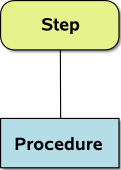
|
A Step describes what shall be done, which change shall happen. It does not fix how this is achieved. The latter happens by assigning a Procedure to the Step. There are different types of Procedures: manual instructions, a refined proceeding or execution of machine operations (invocation of a service). Refined proceedings then may be described with UBPML Steps or BPMN- resp. UML-activities.
|
UML standard |

|
Each Step is associated with exactly one initial Constellation, as well as at least one but possibly several final, mutual exclusive ones. The relationship arrows are borrowed from state transition diagrams (transitions) and named Transformation here.
|
UBPML |

|
xxx
|
UBPML |
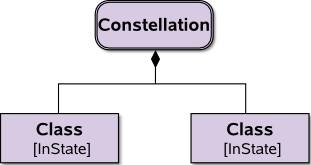
|
xxx
|
UBPML |
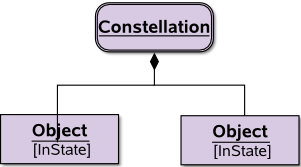
|
xxx
|
UBPML |
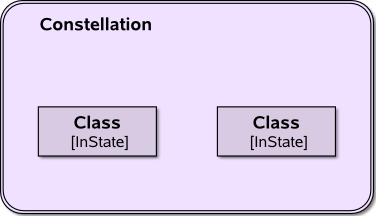
|
xxx
|
UBPML |
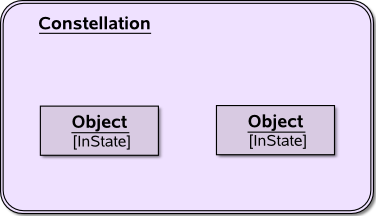
|
xxx
|
UBPML |
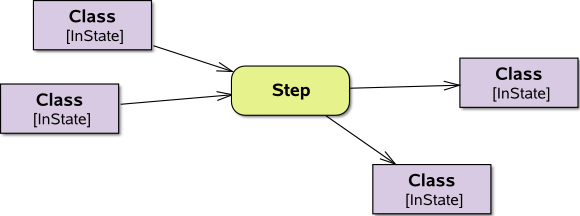
|
xxx
|
UBPML |
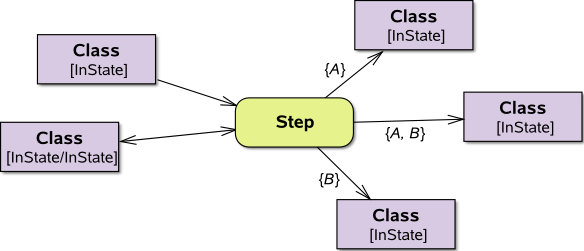
|
xxx
|
UBPML |

|
xxx
|
UML standard |

|
xxx
|
UML standard/UBPML |
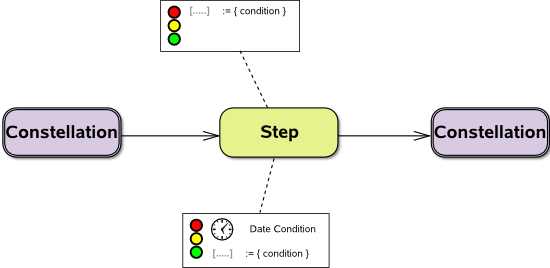
|
xxx
|
UBPML |
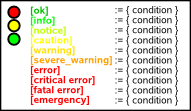
|
xxx
|
UBPML |

|
xxx
|
UBPML |
xxx
|
UBPML | |
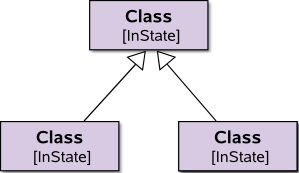
|
xxx
|
UML standard |

|
xxx
|
UBPML |

|
xxx
|
UBPML |
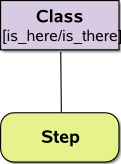
|
xxx
|
UBPML |
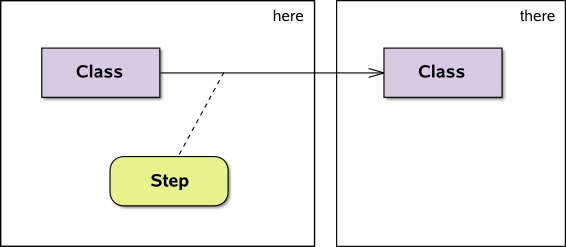
|
xxx
|
UBPML |